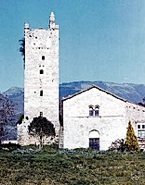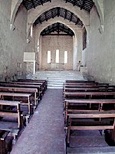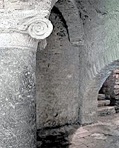


All photographs are from the website
of the Commune of Massa Martana
The church stands on the presumed site of the martyrdom of SS Fidentius and Terence.
An inscription in the crypt that reads "Beatus Fidentius et Terentius hic requiescunt" is in a script that probably dates to the 7th or 8th century.
A community of Benedictine monks seems to have settled here in the 10th century.
The present church, which probably dates to the late 11th century, was first documented in 1276 and was much modified in the 13th century.
The secular clergy took over the church at the end of the 14th century.
It is now private property, but open on Sunday mornings.
Exterior
The red and white façade seems to have been rebuilt in the 13th century. It has a simple portal with a round arch, with a mullioned two-light window above.
The slender campanile to the left, which probably also dates to the 13th century, is built on a dodecagonal base of travertine blocks that was probably a Roman mausoleum (1st century BC).
Interior

The ancient high altar is made from a slab of travertine that covers the presumed sarcophagus of the martyrs.
[A Roman funerary stele - CIL XI 4709 is embedded in the right wall of the presbytery.]
[Inscription - CIL 7862 behind the altar.]
[Reliefs (9th century) on the pulpit]
[A large number of decorative reliefs that probably date to the 11th century are embedded in the back wall of the apse.]
Madonna and Child (15th century)
This fresco fragment in the apse is attributed to Bartolomeo da Miranda.
Crypt

[Relics? Inscription?]




